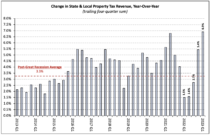NAHB analysis of the Census Bureau’s quarterly state and local tax data shows that $174 billion in taxes were paid by property owners in the first quarter of 2023 (not seasonally adjusted).[1] In the four quarters ending Q1 2023, state and local governments collected $714 billion of property tax revenue.
The year-over-year growth rate of property tax collections is more than twice its 15-year average (6.9% versus 3.3%). In addition to being elevated in historical terms, growth has accelerated substantially each quarter over the past year—quadrupling since Q1 2022.

Property taxes accounted for 35.4% of state and local tax receipts in the four quarters ending Q1 2023 after climbing to 34.7% the quarter prior. In terms of the share of total receipts, property taxes were followed by individual income taxes (29.1%), sales taxes (28.3%), and corporate taxes (7.3%).

The ratio of property tax revenue to total tax revenue from the four sources has been below its pre-housing boom average of 37% for the past five quarters. Compared to single-quarter data in Q1 2022, property and sales tax revenue each increased as a share of the total in the first quarter while the income tax shares (both individual and corporate) each declined.

The share of property tax receipts among the four major tax revenue sources naturally changes with fluctuations in non-property tax collections. Non-property tax receipts including individual income, corporate income, and sales tax revenues, by nature, are much more sensitive to fluctuations in the business cycle and the accompanying changes in consumer spending (affecting sales tax revenues) and job availability (affecting aggregate income). In contrast, property tax collections have proven relatively stable, reflecting the long-run stability of tangible property values as well as the effects of lagging assessments and annual adjustments.

[1] Census data for property tax collections include taxes paid for all real estate assets (as well as personal property), including owner-occupied homes, rental housing, commercial real estate, and agriculture. Owner-occupied and rental housing units combine to make housing’s share the largest among these subgroups.


I would rather see government tax income more than property. Terrible when older people especially have to sell a paid off property due to taxes. With income tax I have income to pay it but don’t owe years there is little income.
Thanks for sharing this insightful blog post! It’s fascinating to see how property tax assessments and revenue adjustment play a crucial role in the construction loan process. Fluctuating home values have a direct impact on loan feasibility and repayment prospects, making effective assessment strategies crucial for construction projects to remain financially viable.